E-bikes are becoming increasingly popular around the East Bay with both adults and youth, which is a great thing.
But along with the growing ridership comes a need for adjustments to our infrastructure, communications, and regulations to responsibly keep pace with the demand.
Youth bike ridership has dropped throughout the United States since the 1960s. 48% of American children walked or bicycled to school in 1969, compared to just 13% forty years later in 2009.
This has been associated with reduced physical activity and health implications for kids, as well as increased car congestion for school pick ups and drop offs, with related environmental and traffic safety impacts.
Youth bike rider fatalities went down over that time period but largely because many fewer kids were biking.
At the same time the number of fatal bike incidents involving adults increased nationwide at an even steeper rate, implying that our streets aren’t working well for bike riders of any age.
Part of addressing these health and safety needs means reducing the number of car trips, by increasing peoples’ mobility options for biking, walking, and taking transit.
E-bikes have shown to be a major opportunity for these trip conversions.
However, several East Bay communities have recently reported safety concerns related to youth on e-bikes, both with regard to the well-being of the riders themselves as well as for pedestrians they interact with.
Many of these issues involve e-devices that aren’t even road-legal, so let’s start with some definitions:
Legal Types of E-Bikes
In California, e-bikes are legally defined as “a bicycle equipped with fully operable pedals and an electric motor that does not exceed 750 watts of power”.
This means existing equipment regulations that apply to standard bicycles also apply to e-bikes (such as required lights, reflectors, etc).
Rules regarding bicycle operation apply to e-bikes as well (such as obeying signs/signals, speed limits, yielding to pedestrians, etc).
Additional regulations apply to e-bikes, based on the classification. In California and most states around the US, e-bikes are divided into three classifications as follows:
Class 1 E-Bikes
- Pedal-assist only
- Max speed 20 MPH
- Can typically be used anywhere regular bikes are allowed*
- No age restriction
- No license / registration
- Helmet required if under 18
*(other local trail or sidewalk restrictions may apply)
Class 2 E-Bikes
- Throttle operated or pedal-assist
- Max speed 20 MPH
- Can typically be used on roadways and most paved trails* (per East Bay Parks trails rules)
- No age restriction
- No license / registration
- Helmet required if under 18
*(other local trail or sidewalk restrictions may apply)
Class 3 E-Bikes
- Pedal-assist only
- Max speed 28 MPH
- Can typically be used on paved roadways but not on most paved or unpaved trails* (per East Bay Parks trails rules)
- Ages 16 and up only
- No license / registration
- Helmet required for all ages
*(other local trail or sidewalk restrictions may apply)
To learn more about the rules of the road for bikes AND e-bikes, practice on-the-bike handling and crash avoidance skills, avoid bike theft, ride at night or in wet weather, and a lot more, check out our FREE adult and youth bike education classes at BikeEastBay.org/education.
Ours is one of the largest free bike ed programs in the country, helping tens of thousands of people around the East Bay to do more and have more fun on every bike trip.
There are other types of devices besides the three classes of e-bikes. They usually fall under the categories of e-scooters, e-mopeds, and e-motorcycles.
Each has a drivers license requirement and associated age limit, and some have state registration and license plate requirements. These are NOT for kids under 16.
If you are interested in an e-device that can go faster than 28 MPH (not an e-bike) we encourage you to look into the legal requirements and restrictions.
No e-device that goes faster than 20 MPH is permitted for youth under 16 years old.
However, some non-street legal devices have been promoted incorrectly as e-bikes, and some e-bikes can have their speed governor disabled illegally.
If you are shopping for a device for your child under 16, it is your responsibility to ensure they are using it safely and legally.

(image credit: njbikeped)
First, we encourage parents to ask whether their child needs an e-bike at all. In many cases the answer is probably “no”.
If they will mostly be riding along off-street trails, separated bikeways, or traffic calmed neighborhood streets without significant hills, a regular, non-e-bike can be a great solution.
Pedal-powered bikes are less expensive, less of a theft target, easier to maintain, lighter, and have no usage restrictions for trails and bikeways.

However, e-bikes can alternately help youth riders who need to carry cargo, travel longer distances, or for whom a standard bicycle is a less accessible option.
If you decide an e-bike is right for your child, we recommend sticking with Class 1 pedal-assist models unless a throttle is necessary for them.
It’s usually easier for a rider of a Class 1 pedal-assist e-bikes to moderate their speed, as opposed to pushing a Class 2 throttle e-bike speed to the maximum.
Both have a 20 MPH maximum assist. But that top speed can still be dangerous in some contexts, or above the posted 15 MPH limit for many of the East Bay’s multi-use trails.
Class 1 e-bikes have fewer usage restrictions than Class 2 models, and are often more difficult to “hack” and disable the speed governor.

(image credit: E-bike positive)
Remember: With either a legal e-bike or a standard pedal-powered bike, a properly fitted helmet is still required for any riders under 18.
Here is some recommended reading before shopping for a youth e-bike:
- Should You Buy Your Kid an E-Bike? – PeopleForBikes (12/5/2024)
- E-bikes and Youth: With Great Power, Comes Great Responsibility – Bikabout.com (7/4/2025)
- Support legislation on the state level to provide more distinction between legal e-bikes versus electric mopeds or motorcycles.
Our partners at the California Bicycle Coalition are sponsoring Senate Bill 455 in 2025, which intends to provide this distinction, while also prohibiting e-devices that don’t fit any category under state law.
— - Implement outreach with local shops and retailers about e-bike regulations and education opportunities when serving parents and kids. Find our list of existing member shops here.
— - Request a free bike class in your East Bay community with our certified bike education program instructors. More info via the request form here.
— - Support funding and organization for youth bike programs to provide positive reinforcement and peer leadership opportunities, to foster a healthy local bike culture. These could include education classes, encouragement activities and prizes, bike clubs, group rides, mechanics workshops, advocacy trainings, and a lot more.
—
Some great examples include Bike Pleasant Hill Elementary’s PTA-sponsored bike club, Oakland’s Scraper Bike Team, Richmond’s Rich City Rides youth bike programs, youth bike repair training internships with Street Level Cycles and Oakland Public Library, or Bike East Bay’s own Concord high school bike club activities operated in 2024.
— - Support data-informed approaches to e-bike and other traffic safety needs.
Official responses involving enforcement must always be contextual and relative to the actual risk, in order to stay on target with regard to overall safety goals.
—
Dangerous driving is still by far the most significant factor with regard to severe and fatal crashes.
—
Even well-intentioned initiatives that take resources and attention away from addressing the primary factors associated with traffic violence can have a negative impact overall.
— - Consult with Bike East Bay on e-bike education and outreach materials.
We have unfortunately seen several jurisdictions and police departments get details wrong on PSAs to inform the public about e-bike rules and safety.
—
We acknowledge that it’s a complicated topic, and new regulations are being added every year.
—
As such, we are happy to coordinate and make sure any materials going out are up to date and accurate.
— - Support the construction of higher quality bikeways across the East Bay to give people more places to ride, reducing congestion and conflicts on the limited multi-use trail network.
—
We have especially heard concerns from cities across the Tri-Valley area about youth e-bike safety issues. But these jurisdictions are currently over-reliant on multi-use trails with little to no protected bikeway construction elsewhere.
—
Here is our score card, ranking Tri-Valley cities on their protected bikeway construction:
—- Livermore: 4 protected bikeways built to date, several more in the works – Not super, but making progress. Grade: C+
- Pleasanton: 3 protected bikeways and 2 protected intersections built to date, several more in the works – Definitely needs to pick up the pace. Grade: C
- Dublin: Zero protected bikeways built to date, despite them being allowed in California since 2016. Several projects in the works but also multiple missed opportunities. Grade: D
- San Ramon: Zero protected bikeways built to date, despite a dozen recommended in their 2018 bike plan. Grade: F
- Danville: Zero protected bikeways built to date, and zero recommended in their 2021 bike plan. Grade: F-
—
- And most importantly, involve local youth in the decision-making process for all the above. They are the ones who will be primarily impacted by any changes, as well as being among those most affected by street safety issues and most in need of mobility solutions.
- Do not implement additional, locally-specific e-bike regulations.
Marin County did this recently, establishing a county-specific Class 2 youth e-bike ban, as well as a helmet requirement for adult Class 2 e-bike riders. As of August 2025 they are now ticketing riders and confiscating e-bikes in some cases, in response to violations.
—
California is supposed to have a universal vehicle code that applies across the state, so people can reasonably know what the rules are as they travel between jurisdictions.
—
However, Marin was permitted to establish their own e-bike rules per a 5-year pilot program authorized by a state bill specific to that county.
—
Even as a pilot program, this is confusing for anyone biking across the county border. But beyond that, the safety justifications Marin County made for the program were already enforceable under pre-existing e-bike rules. The new regulations were unnecessary.
— - Do not implement additional, local e-bike trail restrictions without simultaneously offering upgraded, safe routes for youth riders on parallel corridors.
Local jurisdictions are permitted by the state to restrict any class of e-bike on multi-use bike/walk trails.
—
However, youth e-bike riders will still need to get around. Without trail access they might be forced onto busier streets, and put in greater conflict with car traffic.
—
Decision-makers need to consider even more where youth cyclists can ride safely, and not only where they shouldn’t.
—
East Bay Parks manages and regulates the most extensive trail network in the East Bay. Their rules currently allow Class 1 and Class 2 e-bikes on all of their paved, regional trails, with a 15 MPH speed limit. Similar e-bike rules apply to the Bay Trail network.
—
We encourage local jurisdictions to follow suit, for consistency and transparency.
— - Do not prioritize reactive enforcement as a solution without first engaging in the proactive state legislation, vendor/retailer coordination, program opportunities, and infrastructure initiatives outlined above.
—
Punitive measures should be a last resort, as they could negatively impact the important goal of encouraging more youth ridership and fostering a healthy local bike culture.
Check out this video with more information on phoney “e-bike”-shaped devices, and why they’re a problem:
Do you know of other great resources on this topic, or do you have any questions not answered here?
Get in touch to let us know: BikeEastBay.org/contact
(header image credit: E-bike positive)



